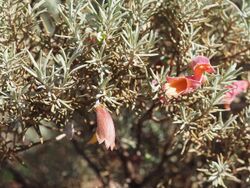Biology:Eremophila pterocarpa subsp. acicularis
| Eremophila pterocarpa subsp. acicularis | |
|---|---|

| |
| Eremophila pterocarpa subsp. acicularis leaves and flowers | |
| Scientific classification | |
| Kingdom: | Plantae |
| Clade: | Tracheophytes |
| Clade: | Angiosperms |
| Clade: | Eudicots |
| Clade: | Asterids |
| Order: | Lamiales |
| Family: | Scrophulariaceae |
| Genus: | Eremophila |
| Species: | |
| Subspecies: | E. p. subsp. acicularis
|
| Trinomial name | |
| Eremophila pterocarpa subsp. acicularis Robert Chinnock[1]
| |
Eremophila pterocarpa subsp. acicularis is a plant in the figwort family, Scrophulariaceae and is endemic to Western Australia. It is a locally common shrub with grey leaves and sepals and a red flower tube which is orange inside.
Description
Eremophila pterocarpa subspecies acicularis is a shrub growing to 0.6–1.8 metres (2–6 ft) high. The branches have raised lumps, especially near their ends and the leaves are narrow, linear to needle-like, 10–18 millimetres (0.4–0.7 in) long and 1–2 millimetres (0.04–0.08 in) wide. The leaves and stems are covered with powder-like short, matted hairs. Unlike those in subspecies pterocarpa, the leaf bases are not twisted[2][3]
The flowers are brick-red on their outer surface, orange inside the petal tube, lack spots and are arranged singly in the leaf axils on a stalk which is 10–16 millimetres (0.4–0.6 in) long. There are 5 sepals which are narrow egg-shaped to triangular and of approximately equal lengths. The petals, which give the flowers their colour are 14–24 millimetres (0.6–0.9 in) long and joined in a tube with 5 lobes at the end. As with the leaves, the sepals and petals have a dusty covering of short, fine hairs. Flowering occurs between June and July and is followed by fruits which are flattened and dry with papery wings.[2][3][4]

Taxonomy and naming
The species was first formally described in 1904 by William Vincent Fitzgerald in the Journal of the Royal Society of Western Australia. When Robert Chinnock reviewed the genus, he recognised the subspecies - E. pterocarpa subsp. acicularis.[1]
Distribution and habitat
Subspecies acicularis occurs between Wiluna and Meekatharra areas where it grows in places that are more rocky or saline than for subspecies pterocarpa.[2][4][5]
Conservation
Subspecies acicularis is listed as "not threatened" by the Government of Western Australia Department of Parks and Wildlife.[4]
References
- ↑ 1.0 1.1 "Eremophila pterocarpa subsp. acicularis". APNI. https://id.biodiversity.org.au/instance/apni/619245. Retrieved 5 September 2016.
- ↑ 2.0 2.1 2.2 Chinnock, Robert J. (2007). Eremophila and allied genera : a monograph of the plant family Myoporaceae (1st ed.). Dural, NSW: Rosenberg. pp. 483–484. ISBN 9781877058165.
- ↑ 3.0 3.1 Brown, Andrew; Buirchell, Bevan (2011). A field guide to the eremophilas of Western Australia (1st ed.). Hamilton Hill, W.A.: Simon Nevill Publications. p. 228. ISBN 9780980348156.
- ↑ 4.0 4.1 4.2 "Eremophila pterocarpa subsp. acicularis". FloraBase. Western Australian Government Department of Parks and Wildlife. https://florabase.dpaw.wa.gov.au/browse/profile/15171.
- ↑ Paczkowska, Grazyna; Chapman, Alex R. (2000). The Western Australian flora : a descriptive catalogue. Perth: Wildflower Society of Western Australia. p. 341. ISBN 978-0646402437.
Wikidata ☰ Q28184646 entry
 |

